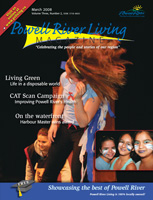Table of Contents
Family Matters
Living Green
Life in the Past Lane
How I Lost My Cool
Back to You
Grand Dame of Natural Health and Healing
I Killed My Best Friend
Explore Powell River
Family Matters
It’s a puppy!!
By Isabelle Southcott
There’s something about a puppy that can make you melt.
Hunter, the newest member of our family, has had me on my hands and knees cooing and talking total gibberish to the “cutest little puppy in the world” on more than one occasion. It’s not just me, both my boys have fallen in love with this adorable Nova Scotia Duck Tolling Retriever that joined our family few weeks ago. And no wonder. This lovable and energetic ball or red fluff has added a whole new dimension to our lives. When he’s not chasing a tennis ball, chewing on a bone, or digging to China in the flowerbed, Hunter can be found flaked out on one of the boys’ laps. “Mom, I’m thirsty. Can you get me something to drink? I don’t want to disturb Hunter, he’s sleeping,” has been used more than once in this household.
He is a good dog…well most of the time. Actually he is teaching us to be good owners and by good, I mean responsible owners. We are slowly learning his signals and he, ours. Good dogs don’t just happen, like children they require work and commitment. As we all know, it takes a long time to make a good dog (and raise a good child). I remember how many times I wished that when my children were born they’d come with a complete list of instructions but I soon learned that raising kids is a bit of a trial and error process. Same with dogs.
During the training process, there are bound to be accidents. Some are funny, others not so funny. When I told my vet that Hunter chewed through the telephone cord the first day we got him, he smiled. “We used to buy telephone cords in bulk when our Golden Retriever was a puppy,” he confessed.
Hunter has had many adventures in the short time he has been with us. He’s gone to (human) school several times…obedience school will soon follow…accompanied us skiing, attended a birthday party and spent hours hanging out with us. My antique bird’s eye maple rocker has been “removed” for a while so I do not have to worry about sharp little teeth gnawing on the rockers.
The other day a friend came over to visit and while we were chatting, I smelled a nasty odour. The puppy was peacefully napping and I couldn’t see any accidents nearby so I asked my friend if he “tooted.”
My friend gave me a funny look and said no so I got up and followed my nose until I saw the pile where the offensive odour was coming from.
After I cleaned it up, my friend asked me to give him some Vicks or something else equally strong so he didn’t get sick from the lingering smell. All I could find was a bottle of perfume so he sprayed himself in that. When he called his wife to pick her up from work, he decided he’d better explain why he smelled of my perfume!
Yes, puppies are wonderful. They love you unconditionally, are always happy to see you and furthermore, they give you a reason to get outside and go for a walk. Hunter has done all this and more in a very short time and we look forward to many happy years together.
Life in a disposable world
How much do you throw away in a day? Convenience has become an integral part of our daily lives, and it has led us down a path littered with single-use items. Stories of garbage crises are increasingly common, and it is apparent that if we don’t reconsider and curtail the rate at which we consume, it won’t be long before we bury ourselves in the refuse.
When you go out for coffee, when was the last time you had one in a porcelain cup? The last time you bought groceries, how much of your cart was filled with food, and how much was packaging?
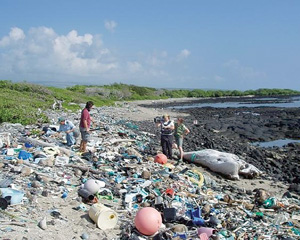 Our society is so disposable that it’s almost always cheaper to replace something than it is to use it again or fix it when it breaks. Even if we want to resist this trend, it can be difficult. How many times have you heard people say, “They just don’t make (fill in your preferred word here) like they used to”? And never has that been truer than it is today.
Our society is so disposable that it’s almost always cheaper to replace something than it is to use it again or fix it when it breaks. Even if we want to resist this trend, it can be difficult. How many times have you heard people say, “They just don’t make (fill in your preferred word here) like they used to”? And never has that been truer than it is today.
When your toaster last broke, did you fix it or have it fixed? My bet is that you tossed it out or (hopefully) recycled the parts that you could, and went out and bought a new one. And the new one cost you very little. What about your blender? VCR? (What’s a VCR again?—Oh right, they were those machines we used before there were DVD players). How long did your last computer live before you replaced it? What about your TV? There’s no doubt it’s nice to have new things. Who wouldn’t prefer something shiny and new over something old and tired? But this demand for convenience and shiny new does not come without a cost. In fact it comes with a higher cost than could ever be measured in dollars and cents.
We live in a consumer society. Product manufacturers are smart! Why would they sell their consumer something that lasts for 25 years if they can sell something that lasts for 5 and then sell another one? Furthermore, that’s what we’re asking for. People want cheap, and that’s exactly what we’re getting. But long-term? It doesn’t take a rocket scientist to figure out that it’s not sustainable. The artist Chris Jordan has recently done a series called Running the Numbers: An American Self-Portrait. It is a unique and stunning look at the rate of American consumption today. Look for his work here: www.chrisjordan.com/current_set2.php.
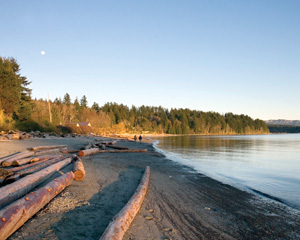 The good news is that we can make big changes with just a small shift in mindset. The more you analyze your own space and life, the more possibility for change you will find. It takes a bit of planning, it takes a certain amount of thought. But change is not impossible, nor is it difficult. As a first step, take a look at your house and lifestyle on any typical day. Measure how many disposable items you use regularly, and consider what non-disposable items you could replace them with.
The good news is that we can make big changes with just a small shift in mindset. The more you analyze your own space and life, the more possibility for change you will find. It takes a bit of planning, it takes a certain amount of thought. But change is not impossible, nor is it difficult. As a first step, take a look at your house and lifestyle on any typical day. Measure how many disposable items you use regularly, and consider what non-disposable items you could replace them with.
A less disposable lifestyle?
- Carry a reusable cup with you. Then, when you stop for a coffee or other drinks, you will be ready.
- Avoid single-use items like paper plates, disposable cutlery, paper napkins and paper towels. All have multi-use alternatives that are nicer to use and will save you money.
- When you grocery shop, look for less packaging or types which will break down easily (e.g. not Styrofoam).
- Carry re-useable bags with you when you shop to avoid using plastic or other single-use bags.
- When shopping for any multi-use item, look for things that are well made—they may be more expensive initially, but will be better value in the long term.
- Educate your children about this issue. It is their attitudes that will make the long-term difference.

Life in the past lane
Powell River’s Historic Townsite
By Diana Collicutt
We discovered Powell River’s Townsite, really quite frankly, by accident in the early ‘90s. Deciding to explore the upper Sunshine Coast, we set out to embark on a new life away from the bustling, busy, big city life. Following the winding road of Highway 101, we were quite surprised to find the community of Townsite. Located in the industrial heartland of Powell River, we had discovered a relatively intact, architecturally significant, and very charming heritage area! I had just finished my urban geography degree and had contemplated such planning concepts as Ebenezer Howard’s ‘Garden City,’ a progressive planning model originating from England in the early 1890s, and I soon learned Ebenezer had a hand in the development of the historic Townsite, and maybe even why I was here.
As we settled into our new life, we became involved and Townsite’s colourful history began to unfold. The development of Townsite began in 1910 and was entirely built and provided for by the Powell River Company, a Minnesota-based Brooks & Scanlon organization, one of the continent’s largest sawmill operators of the day. Dr Dwight F. Brooks, Anson Brooks and Michael J. Scanlon were the Company’s founding members, and established what would become, the largest pulp and paper mill within North America.
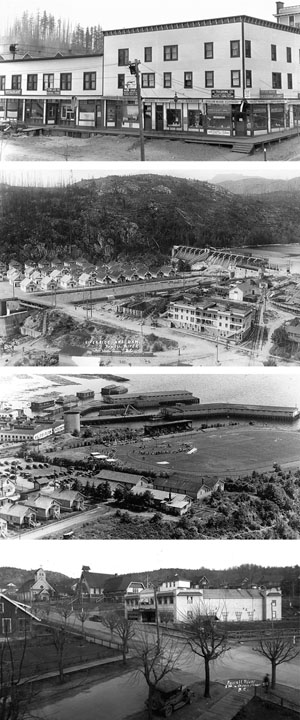 Earlier, Dr Brooks was employed in a teaching hospital in St. Paul, Minnesota and was also an investor in lumbering and sawing mill operations. Forever in search of timber leases and partnerships, Dr Brooks found himself in Bend, Oregon during the late 1800s, where he met Michael J. Scanlon, who was mainly involved in railway logging operations. They formed a partnership, the ‘Brooks, Scanlon and O’Brien’ railway operation and soon worked their way up the Pacific Coast. By 1890, the organization was operating south of Powell River. While scouting Powell River and Powell Lake, Brooks and Scanlon realized the enormous forest resource and power potential of the area, and were ambitious to secure the timber leases and river rights from the Province of BC. They organized the Powell River Company that was incorporated in 1909, the Townsite was plotted in a compact grid-iron pattern in 1910, and the first roll of paper was produced on April 12, 1912.
Earlier, Dr Brooks was employed in a teaching hospital in St. Paul, Minnesota and was also an investor in lumbering and sawing mill operations. Forever in search of timber leases and partnerships, Dr Brooks found himself in Bend, Oregon during the late 1800s, where he met Michael J. Scanlon, who was mainly involved in railway logging operations. They formed a partnership, the ‘Brooks, Scanlon and O’Brien’ railway operation and soon worked their way up the Pacific Coast. By 1890, the organization was operating south of Powell River. While scouting Powell River and Powell Lake, Brooks and Scanlon realized the enormous forest resource and power potential of the area, and were ambitious to secure the timber leases and river rights from the Province of BC. They organized the Powell River Company that was incorporated in 1909, the Townsite was plotted in a compact grid-iron pattern in 1910, and the first roll of paper was produced on April 12, 1912.
The Townsite developed into an outstanding example of a professionally-planned, single industry, company town of the early 20th century. During this era, the prevailing attitude among industrialists was characterized by the goal for profit and disregard to the working class and their families. Across industrial nations, the conditions in the mines, factories and mills reflected squalor and disease-ridden environments. However, an influential planning movement began to evolve in England in the late 19th century; that of Ebenezer Howard’s ‘Garden City’.
Brooks and Scanlon were visionaries and eagerly embarked upon this model, employing the Garden City concept into the planning and design of the town. The concept design was to soften the impacts of industrialization and formulate a ‘pre-designed plan to create a liveable industrial town, providing quality housing as well as schools, churches, government offices, department stores, and cultural, recreational and health care facilities for its employees,’ entirely surrounded by green space and gardens, in order to mitigate the negative impacts of industry.’ By enhancing community liveability for the residents, mill founders could expect their employees to be happier and healthier and thus more productive; it was postulated a more satisfying life, would achieve greater ‘intellectual, moral and physical development.’ This vision resulted in a town plan that consisted of a self-sufficient, compact, and entirely complete community; a plan founded to provide homes and amenities for workers and their families that would encourage people to relocate to the isolated wilderness on the BC coast.
The surveyed grid pattern was purposely designed to radiate outward from the mill site. This area, in and around the Rodmay Heritage Hotel, served as the town’s core and marked the original entrance to the Powell River community. Development was a result of pedestrian access and horse-drawn carriage, as reliance on the automobile was not yet embedded in society. Wooden boardwalks lined the streets, as well as rows of trees and gardens. Steam locomotives would haul massive timbers and rumble through the Townsite on the way to Michigan’s Landing.
A favourite community outing was by train to Michigan’s Landing for the regular Sunday picnic. The track was taken up in 1926, but the railway bed remained in place from the former golf course to Willingdon Beach. This trail was referred to as ‘Lovers’ Lane;’ without reserve, we know it as the Willingdon Beach Trail!
Early architecture of the Townsite can be described as a variant of the Tudor Revival and California Bungalow styles, both influenced by the Arts and Crafts architectural movement of the 19th century. This architectural design ensured buildings were constructed with high attention to detail, emphasizing simplicity and quality workmanship, while making use of local natural materials. The movement philosophy anticipated one would be a better person if stimulated in the “hand, head and heart” and “that a greater good would arise with respect to community, industrial stability and productivity” if employed in the design. It conveyed quality and high standards and emphasized a greater appreciation for the natural environment. The design identified practicality and rationality, characteristics in direct contrast to the former Victorian era of ‘excess ornamentation’.
With a bit of history behind us, living in the past was not faulty circumstance and for this story, I set out to ask my neighbours why they chose the Townsite community as their home. It was not surprising to find several, common underlying reasons. For many, living in the Townsite provides a real connection to the town’s history and ‘spirit of place’ in Powell River. When asked, residents love first and foremost, the real sense of community. There is a closeness of heart living in the Townsite, we all know each other and look after one another. Great friendships have formulated. There is cohesiveness and similarity in that we all live together with a real sense and respect of the past; an ‘enduring foundation’ as one resident said.
Another underlying, yet obvious reason we love the Townsite, is the unique Arts and Crafts heritage architecture. It is true that quality craftsmanship and high standards stimulate the “hand, head and heart.” Townsite residents love their homes and take significant pride in preserving and restoring the architecture; visitors to our homes are always amazed. Many residents have invested significant time and money in restoration projects, taking special care to preserve heritage details, such as old growth wood trim, heritage doors, windows, natural fir floors and grand staircases. Individual restoration work is tedious and time consuming, however the payback is priceless. As one resident explained, ‘by honouring our past, we are making work for today.’ Residents have a great appreciation for the heritage architecture and quality workmanship, and continue to work hard to ensure it is preserved and remains intact.
Living in a community with grand architecture and a vibrant past is unique; however what sets Powell River’s Townsite apart, is how this heritage community is unusually distinguished by a natural boundary encompassing vast green spaces of second growth forest with interconnecting trails, fresh water lakes, streams, a spectacular ocean waterfront and panoramic views. The west of south facing orientation is not unlike that of West Vancouver, and we often take for granted the passive solar energy provided for by this backdrop. As one resident stated, ‘there really isn’t anyplace that I know of in Canada such as the Townsite’. ‘We can step out our door, and without getting in our car, arrive at a forest, lake and ocean, albeit within short walking distance’. This is simply astounding.
Gloria Riley, a long-time resident who was born in the former St. Luke’s Hospital in 1931, has many fond memories. When Gloria and her husband Harry were married in 1951, they were living in Cranberry Lake. She had always wanted to live in the Townsite and they eagerly had their names placed on the waitlist for a house. Gloria always looked forward to the regular family outings from Cranberry Lake to Townsite for shopping at the ‘Powell Stores’ to purchase food and supplies. They always traveled on foot. The Powell Stores were the large Company stores, located in what is known as the ‘Townsite Mall’. This building was constructed by the Company in 1941, with a modern design to replace the original Sing Lee Store. Sam Sing was a Chinese immigrant who provided laundry, grocery service and rented space to other merchants. The Company had always wanted to buy out their competition and was finally successful in 1923, when Sam Sing relocated, albeit unwillingly, to the Shingle Mill area on the north side of the river.
Gloria did finally moved to the Townsite in 1952 to a house at the foot of Poplar Street and remembers a time when the Company added to the rent, a $2 monthly charge for electricity; and if one lived on Larch or Laburnum Avenues, another $2 for the view! As her family grew, they moved several times, and eventually scraped enough money together to purchase their home on Marine Avenue in 1964. Gloria has witnessed many changes over the years, yet continues to appreciate the sense of community, the natural setting and vivid connection to the past.
Specifically the Townsite was designed to incorporate a compact mix of industrial, commercial, residential and recreational uses, abundant with gardens and green space; a planned design to foster community, health and quality of life. Interestingly, the eco-planning models of this 21st century aim to encourage mixed-use development, smaller lot sizes, less reliance on the automobile, self-sufficiency and a strong connection to the environment is not unlike Ebenezer’s 19th century Garden City! I therefore wonder, am I really living in the past, or is the Townsite a fine example of an urban planning archetype of the future? And further, what special aspects are at work in this neighbourhood to successfully create community? Is community a direct result of the people, the place, the landscapes or the built architecture? In Townsite, there is more to our community than just the homes, the gardens and the streetscapes; there is a definite spirit of place. And this spirit of place can only be experienced by the abundant history that repeatedly connects the world of yesterday, with our present day society.
How I lost my cool
By George M Campbell
We had a ‘cold’ crisis over at our house recently. No, neither the wife nor I caught a cold (we’d taken our flu shots last November as per usual), and neither did we get cold because the furnace stopped working. Our crisis was quite the opposite. We were looking to find some cold and we couldn’t because our fridge quit.
I got up one morning and opened the top door of the fridge to find the ice trays full of water and two quarts of melted ice cream on the bottom of the freezer. I cleaned up the mess then pulled the fridge out from the wall to see if it was plugged in. It was. I vacuumed the dust off the coils at the back then fiddled around a bit with the controls. But it wouldn’t start. And so, while my wife scrubbed the floor where it had been sitting, I picked up the phone and called our appliance repair guy.
He arrived shortly after lunch and had no better luck than I’d had. Oh, he gave it a little mouth to freezer resuscitation, and tried a few tricks with the electric motor, but to no avail. Quietly, he put his tools away, looked at me sadly, and with one hand on the appliance and the other over his heart, he pronounced it dead. After thirty-one years, our fridge had expired.
Off went the wife and I to our friendly neighbourhood appliance store to buy a new refrigerator. I quickly discovered that our new fridge was going to be determined by two different sizes. One was the space available in our kitchen under the cupboards, and the other was the size of my wallet. Wow, the price of refrigerators had gone up some in the past thirty-one years!
We finally settled on one that was pretty much a replica both in size and shape as our old refrigerator. It cost a whopping $799. At least I thought that’s what it cost, but ‘oh boy!’ did I ever have a few things to learn. To that price was added the delivery charges, then the taxes, plus the cost of getting rid of the old one. (That alone came to a whopping $90. Sixty bucks to have it hauled away plus thirty more to have the refrigerant removed.) When I added in the money I’d paid the appliance repair guy for the service call, I found I had spent $1006.42 — and I didn’t even have the new refrigerator yet because they couldn’t deliver it for four days.
Now, I am a creature of habit, and some of these habits I have had for a very long time. Like drinking a cold beer from a frosted glass around lunchtime every day, and maybe a glass or two (also frosted) of vodka and tonic over ice around 4 o’clock in the afternoon. Old habits die-hard and mine didn’t show the slightest sign of dying at all… but it’s very difficult to have frosted glasses, cold beer, and ice cubes when you haven’t got a refrigerator. I tried drinking the beer at room temperature, but I found it not only non-thirst-quenching, but downright distasteful. As for vodka and tonic without ice—well, how uncivilized can a guy get?
I toughed it out for two days, but couldn’t make it through the third. On that day in the early afternoon I arrived wild-eyed and thirsty at the store where I bought the refrigerator and began begging, pleading, whining and crying for them to deliver the blessed thing. They gave up around 3 pm and by 4:30 our new refrigerator sat in our kitchen, plugged in and running smoothly.
Now that our cold crisis is over, I am left wondering about two things. (1) How did we ever manage before refrigerators were invented? And (2) how did the floor under our old fridge get so incredibly dirty?
Back to You
A conversation with Glen Roscovich
By Stuart Isto
At the opening ceremonies for the Powell River Film Festival this year it was a special treat to hear Glen Roscovich and a group of singers and musicians perform Powell River’s song, “Back to You, Powell River.” Song sheets were passed out to the audience and a recording was made with the crowd singing along.
I asked Glen for an interview to talk about the song, how it came to be, and what were his plans to popularize it. We sat down on a Sunday night to talk about it.
Stuart: Tell me about what you’ve done. You’ve been a dive…
 Glen: I’ve worked telephone, communications, aquaculture, presently communications. I was in the Arctic for 11 years. Music has been a life long hobby.
Glen: I’ve worked telephone, communications, aquaculture, presently communications. I was in the Arctic for 11 years. Music has been a life long hobby.
Stuart: You’ve written other songs as well as the Powell River song?
Glen: I wrote the song for the first salmon-farming music video produced by my daughter, Twyla called “Song of the Seafarm.” This won the Best Music Video Award at the 1996 Canadian International Amateur Film Festival.
There was a TV show called “The Westerly,” produced by Judy Tyabji and Gordon Wilson. I wrote the theme song for that. Judy was hosting the Blackberry Festival Wine and Cheese Fest that year and mentioned that they were going to get Valdy to write the theme. I decided to beat him to the punch and wrote one later the same evening. The song was called “Big Westerly.” I was also part of the team that created the theme song for their locally produced TV pilot, “Serving Thyme,” along with Gordon, Dan Erickson and Walter Martella.
Stuart: How long have you been playing music?
Glen: Oh, a long time, but I never really studied it—mostly for parties and playing with friends. The guitar I have really projects the song well. It’s a Seagull, made in Quebec. I also sometimes play harmonica with the Avatar blues group even though I don’t know much blues. You can’t lay back with a one-note instrument like the harmonica. You hope to have enough creativity to come through.
Stuart: What year was it you wrote the Powell River song?
Glen: 2002. It would have been about June. Heading home from the island on the ferry I just felt like writing something out there in the middle of the strait. By the time I got to the Powell River side I pretty well had it down.
Stuart: Were you born in Powell River?
Glen: No, I was born in Alberta, in the foothills of the Rockies. I’ve been here most of the time since I was 2, graduated high school in Powell River. Growing up, I hung around with a musical friend. I left town in the early 70s. There was nobody around who played music so I had to play it myself. Mostly folk style with some country and rock. Later out on the fish farm up the coast I had to entertain myself during the long winter nights and got better on the guitar. I had always written poetry and stuff like that. When I first heard Leonard Cohen’s music it really opened my eyes to the potential of a song. He put more substance into a song than I realized there could be.
Stuart: What kind of official recognition has the song gotten?
Glen: The mayor is one of my biggest supporters. I was invited to perform it for City Council along with Steuart Ferguson and Monty Drake about a year and a half ago. Carol Hamilton originally recognized the song and featured it in a cultural diversity event in 2002. Two Canada World Youth events here also used the song. The Indonesian and Namibian exchange students really liked it. I opened three or four Sea Fairs and Canada Day events as well as well as last year’s CNIB national convention.
Stuart: How do you hope to popularize the song?
Glen: What I would like to do… I gave the song to Powell River a couple of years ago. I thought, “gee, nothing is happening with it, I’ll have to put some more effort into getting it out there.” It always gets a good response.
There is such an amazing choral tradition in our town but not much gets sung about Powell River itself. I’d like to invite any and all singing groups here to learn the song. We would record and video each group performing, then shoot a scenic backdrop to mix in with each performance—all to be assembled into one DVD.
I have had a lot of fun with this song over the past five years and would really like to pass it along to the community at large.
Richard Olfert has come up with an arrangement that works quite well. I know there are more and more of us who have come “back to you, Powell River.”
Stuart: Thanks very much. I hope that soon everyone in Powell River knows the song.
Back to You, Powell River
Like an inland sea, Straights of Georgia,
Vancouver Island, the western shore;
Her rugged mountains, cold and lonely,
Protect us from Pacific storms.
Chorus
Back to you, Powell River,
Salt chuck keeps us on our own;
Lakes and forests, sunset beaches,
Texada shelters our western home.
Out by Rebecca, Harwood and Savary
Whales and dolphins wander there;
Sliammon elders, the hulks at Townsite,
Strong connections with days before.
Chorus
Powell River people, warm and friendly,
Welcoming strangers from distant shores;
They see an Eden still close to nature,
The ocean’s rhythms become our own.
Being Green
Grand dame of natural health and healing
By Isabelle Southcott
Most Powell Riverites interested in natural health and healing and health food products have walked across the threshold of Stella Gillies shop more than once.
Kelly’s Specialty Shop on Willingdon Avenue is this community’s oldest health store. Yet, despite being in the industry for more than 35 years, Gillies still finds each day exciting.
“You never know everything. That is the most exciting part about this. You get people coming in and giving you tips. The public is so much more informed today than they used to be. They’ve got the net and Alive Magazine.”
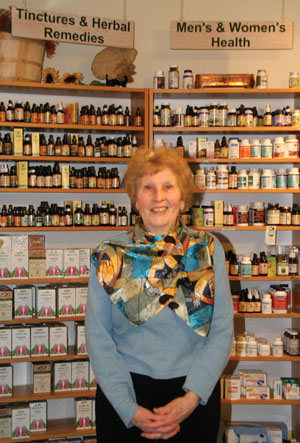 Before purchasing Kelly’s, Gillies worked at the store for eight years. In those days it was located on Joyce Avenue near the present day location of Westview Medical Clinic. “It was owned by Ann McKenzie and her husband whose nickname was Kelly,” Gillies explained. “Ann decided to retire and so we bought it. I was going to do this for three years but I could not let it go…it is all so interesting.”
Before purchasing Kelly’s, Gillies worked at the store for eight years. In those days it was located on Joyce Avenue near the present day location of Westview Medical Clinic. “It was owned by Ann McKenzie and her husband whose nickname was Kelly,” Gillies explained. “Ann decided to retire and so we bought it. I was going to do this for three years but I could not let it go…it is all so interesting.”
Kelly’s specializes in health food and herbal remedies. “We have specialized food for people with digestive problems, we have non-wheat and non-dairy products and gluten free products. We have herbs and organic foods and vitamins,” said Gillies looking around her shop.
One of Kelly’s newest products is Salba, which comes from the white Chai seed. “They’ve found that it helps bring blood pressure down very quickly. I’ve had two people come in who do not know each other and they both told me it brought down their blood pressure in seven days. You can do a lot without pills if you know what to do,” Gillies added.
Gillies and her staff pride themselves on providing service with knowledge. “If people need something specialized we will special order for them. “
Long-term relationships are important to Gillies. “I’ve spent over an hour talking to someone about their problems and had them leave with nothing in their hands but literature,” she said.
In keeping with continuing education, Kelly’s has just hired a health nutritionist to work at the store. That, said Gillies, is another part of her commitment to inform the public. “When I was growing up my father used to put wheat germ and molasses on my porridge and feed me cod liver oil and malt. I’m grounded in this. I make everything from scratch, I don’t use processed foods, I prefer raw foods. I make my own jams, jellies and yogurts because I want to know what goes in them.”
Gillies and her husband Reg have three children. They moved to Canada from England in 1956 and to Powell River in the 1970s. They ran a restaurant in Cranberry called the Owl’s Roost for four years before Reg began working at the mill.
When Gillies looks back over her long and interesting career, she feels a deep sense of satisfaction. “It’s been a great way to get to know people. I love people, we’ve had customers for years and years, it’s been a very rewarding experience and one I will always cherish.”
I killed my best friend
By Robin Rourke
Now that I have your attention please read on, especially if you are a dog owner.
Please allow me to take you back a year ago in time. After carefully selecting a reputable breeder, I brought home my beautiful yellow Lab puppy. Amber quickly stole my heart and my affection and grew to be a loyal companion and friend. She was everything I had hoped for in a dog.
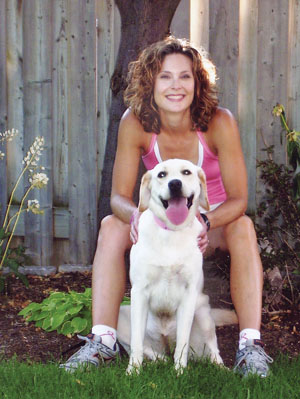 The day that she died began like any other day. Routinely every morning before breakfast, she and I went outside to the backyard so she could relieve herself and I could feed the birds. My recently purchased cylinder-shaped birdfeeder was almost empty after having sustained the feathered creatures for over two weeks. Before filling the feeder with fresh seed, I removed the clump of seed stuck in the bottom. Amber, having eaten misplaced birdseed on a daily basis, was quick to gobble up the more solid version. Neither of us gave it a second thought until two hours later when she began vomiting.
The day that she died began like any other day. Routinely every morning before breakfast, she and I went outside to the backyard so she could relieve herself and I could feed the birds. My recently purchased cylinder-shaped birdfeeder was almost empty after having sustained the feathered creatures for over two weeks. Before filling the feeder with fresh seed, I removed the clump of seed stuck in the bottom. Amber, having eaten misplaced birdseed on a daily basis, was quick to gobble up the more solid version. Neither of us gave it a second thought until two hours later when she began vomiting.
Her extreme vomiting and later, very lethargic behaviour, was the beginning of a horrific string of events that would lead to her tragic death 12 hours later. Despite receiving every veterinarian care and intervention available, her young body ceased to function. She was in acute liver failure and nothing worked to stabilize her. It was the most horrific experience my heart and mind has ever endured. Despite my shock and obvious grief, I requested an autopsy. I had to know what had happened to my best friend. Why, at a very healthy 13 months, did she die? I was in shock and I needed answers.
My answer came two weeks later; the autopsy results revealed her sudden death was the result of aflatoxin poisoning. Aflatoxin is a naturally occurring toxic chemical by-product from the growth of fungus Aspergillus flavus on corn and other crops. Grains are particularly susceptible to this fungus following prolonged exposure to a high humidity environment. Crops frequently affected include corn, millet, rice, wheat, peanut, soybean, sunflower, spices and tree nuts. The ingredients listed on my birdseed bag contain these grains. The seemingly innocent clump of seed infected with this poisonous fungus, ultimately proved to be lethal for my Amber.
I cannot, no matter how many tears I shed, nor how big the hole in my heart is, bring her back to life. She is dead. I can, however, warn other loving dog owners and bird watchers alike of the very real danger of mouldy birdseed.
Judging a book by its cover
By Roger Whittaker
[Holism is] the tendency in nature to form wholes that are greater than the sum of the parts through creative evolution.
Holism and Evolution, Jan Smuts, 1926
Each of us is as intimately attached to the soil of this beautiful country as are the famous Jacaranda trees of Pretoria and the Mimosa trees of the Bushveld—a rainbow nation at peace with itself and the world.
Nelson Mandela, 1994
Casual brush strokes wielded upon a canvas—water added to the paint causes runs, looking like light reflections after a rain. Colours sweep down the picture where representations of people remain untouched by the dripping wild rainbow. It was that simple when Lee Mackenzie first created Rain Brings Out The Colours. An artist experimenting with her craft, she discovered the combination of technique and physics to combine and create a picture worthy of her abilities. She went about her business after offering the piece for sale with the many others already posted on leemackenzie.com.
 Then, in 2004, MacKenzie received a letter from South Africa. J.P. and Ria Smuts had compiled a textbook to be distributed to grade 10 students who were learning a new way of thinking about themselves and about themselves in relation to one another while the peoples of South Africa underwent massive reform with the implementation of the Promotion of National Unity and Reconciliation Act (1995). J.P. and Ria Smuts had discovered Rain Brings Out The Colours on Mackenzie’s website and thought it germane to the contents of their text. The letter requested permission to use the painting for the cover of their publication. Thrilled, Lee Mackenzie sent a limited edition print to the authors and asked for a copy of the book.
Then, in 2004, MacKenzie received a letter from South Africa. J.P. and Ria Smuts had compiled a textbook to be distributed to grade 10 students who were learning a new way of thinking about themselves and about themselves in relation to one another while the peoples of South Africa underwent massive reform with the implementation of the Promotion of National Unity and Reconciliation Act (1995). J.P. and Ria Smuts had discovered Rain Brings Out The Colours on Mackenzie’s website and thought it germane to the contents of their text. The letter requested permission to use the painting for the cover of their publication. Thrilled, Lee Mackenzie sent a limited edition print to the authors and asked for a copy of the book.
Less than six months later, MacKenzie held a copy of Reën Boog, which is Afrikaans for Rainbow, in her hands. Slowly she turned the pages, looking at the words in the strange Afrikaans language. Toward the center of the textbook, Lee was surprised to discover a full page dedicated to Rain Brings Out The Colours, with about a dozen questions following. The Afrikaans was translated by a friend who told her the questions were asking young readers to first imagine what the mind of the artist was thinking as she created the painting. Then they were asked to turn their own minds toward the painting and ask themselves a host of questions from many points of view. What are the people in the painting thinking or doing? How does the painting make them feel? On the pages following Rain Brings Out The Colours were paintings by Van Gogh and da Vinci—august company indeed. Interestingly, Archbishop Desmond Tutu coined the term Rainbow Nation to describe the nation in 1994 after the official end of apartheid.
Mackenzie is no stranger to South Africa. While working for CHEK-TV in Victoria she was invited to come to South Africa as part of an effort to increase international awareness of South Africa as a tourist destination. The sanctions had been lifted and Mandela was free. The entire nation was on tenterhooks as they waited to see if peace or civil war loomed around the corner. MacKenzie agreed to go so long as she was not compelled to produce candy-coated stories focused on hot nightspots, beaches and hotel offerings. For two weeks, accompanied by Dennis Moore, a news cameraman, they made their way through much of the republic’s less travelled and completely unrepresented regions, where factions were often separated only by the width of a street and the threat of death by machete was her constant cohort. That journey is now a memory in sharp contrast with her thoughts of thousands of students heading off to high school with Reën Boog sticking out of their rucksacks, sporting its brightly coloured cover Rain Brings Out The Colours.
Mackenzie is now living in Powell River, experiencing less notoriety since leaving the world of television news and quietly recreating herself as an artist at Studio 3 on Marine Avenue.
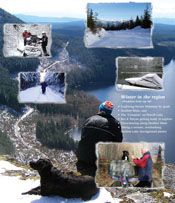
Winter Wonders
by Wayne Lutz
